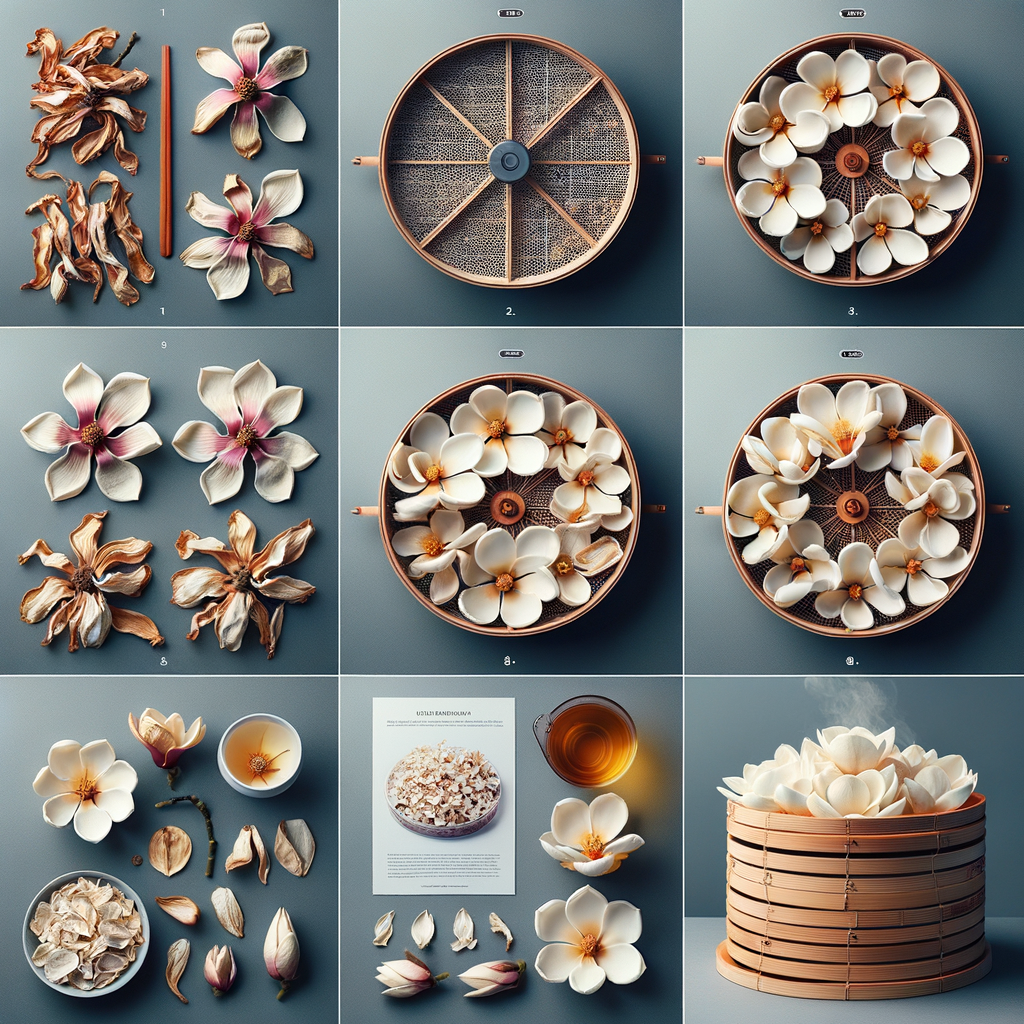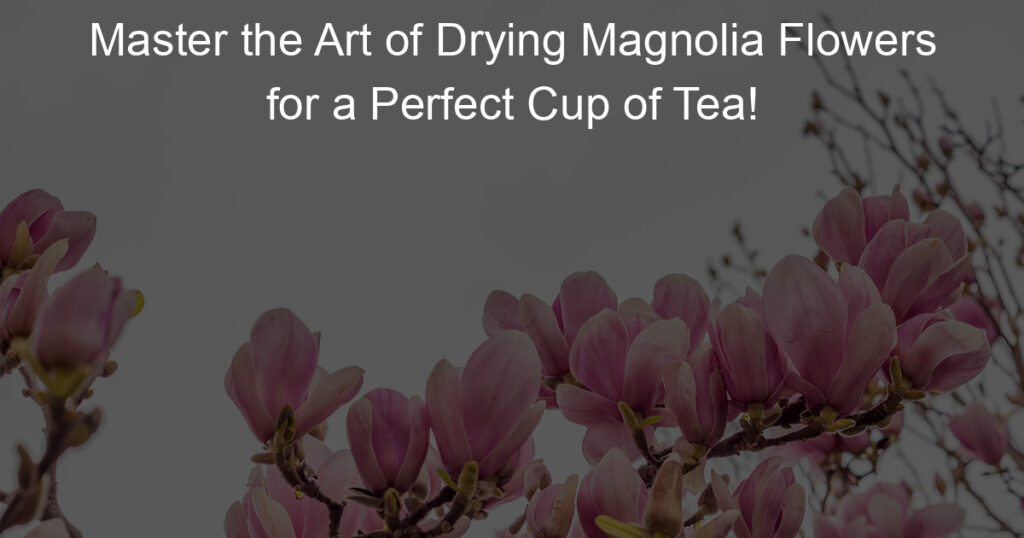
Introduction to DIY Magnolia Tea
Welcome to the world of DIY Magnolia Tea! This post will guide you through the fascinating journey of this aromatic beverage, from its humble origins to the reasons why making it yourself can be a rewarding experience. Let’s dive in!
-
- What is Magnolia Tea?
Magnolia Tea is a soothing, fragrant beverage made from the dried petals of magnolia flowers. It’s known for its sweet, floral taste and its calming properties. This tea is not only a delight to the senses, but it also offers a range of health benefits, which we will explore later in this post.
-
- The history and origin of Magnolia Tea
Magnolia Tea has a rich history that dates back hundreds of years. Originating in East Asia, it was traditionally used in Chinese and Korean medicine for its therapeutic properties. The magnolia flower, from which the tea is made, is highly revered in these cultures for its beauty and fragrance. Over time, the popularity of Magnolia Tea spread across the globe, and today it’s enjoyed by tea lovers everywhere.
-
- Why DIY Magnolia Tea?
Creating your own Magnolia Tea at home is a fun and rewarding process. It allows you to control the quality of the ingredients, ensuring you get the best flavor and health benefits. Plus, the process of drying the flowers and brewing the tea can be a therapeutic activity in itself. Not to mention, DIY Magnolia Tea makes for a unique and thoughtful gift for the tea lovers in your life!
Now that we’ve covered the basics, let’s move on to the next section where we will discuss how to dry magnolia flowers for your homemade tea. Stay tuned!
Drying Magnolia Flowers
One of the most important steps in creating your own Magnolia tea is drying the flowers. This process allows you to preserve the flowers and their beneficial properties for a longer period. Let’s explore how to do this.
How to Dry Magnolia Flowers
There are several steps involved in drying Magnolia flowers. We will guide you through each step to ensure you get the best results.
-
- Choosing the right Magnolia Flowers
Not all Magnolia flowers are suitable for drying. You should look for flowers that are in full bloom, free from insects or disease, and have a vibrant color. This ensures that the dried flowers will have the best flavor and health benefits.
-
- Preparing Magnolia Flowers for drying
Once you’ve chosen the right flowers, it’s time to prepare them for drying. Start by gently washing the flowers to remove any dirt or insects. Then, pat them dry with a soft cloth. Be careful not to damage the petals during this process.
-
- Methods of drying Magnolia Flowers
There are several methods you can use to dry Magnolia flowers. The most common methods include air drying, oven drying, and using a dehydrator. Each method has its own advantages and disadvantages, so choose the one that suits your needs best.
Air drying is the simplest method and involves hanging the flowers upside down in a dry, dark place. This method can take several weeks, but it preserves the color and scent of the flowers very well.
Oven drying is faster, but it requires careful monitoring to prevent the flowers from burning. To oven dry, spread the flowers on a baking sheet and place them in a preheated oven at a low temperature. Check the flowers regularly and remove them once they are dry.
Using a dehydrator is the fastest method, but it requires a special appliance. If you have a dehydrator, simply spread the flowers on the trays and set the temperature as recommended by the manufacturer. The flowers should be dry in a few hours.
Regardless of the method you choose, make sure the flowers are completely dry before storing them. Any moisture can lead to mold growth and spoil the flowers.
Storing Dried Magnolia Flowers
After the careful process of drying your Magnolia flowers, it’s essential to store them properly to preserve their quality and aroma. Let’s delve into the best practices for storing dried Magnolia flowers and how long they can be stored.
-
- Best practices for storing dried Magnolia Flowers
Storing dried Magnolia flowers isn’t complicated, but it does require some attention to detail. Here are some tips to ensure your flowers remain fresh and fragrant:
-
-
- Use Airtight Containers: Store your dried Magnolia flowers in airtight containers. This prevents moisture from seeping in and causing mold or mildew.
- Keep Away from Light: Direct sunlight can fade the color of your dried flowers and reduce their fragrance. Store them in a cool, dark place.
- Avoid Heat: High temperatures can cause the flowers to become brittle and lose their aroma. Avoid storing them near heat sources like radiators or ovens.
- Don’t Overcrowd: Give your flowers some space. Overcrowding can lead to damage and loss of shape.
- How long can you store dried Magnolia Flowers?
-
The longevity of your dried Magnolia flowers largely depends on how well they’re stored. With proper storage, they can last up to a year without losing their aroma and aesthetic appeal. However, for the best experience, it’s recommended to use them within six months.
In conclusion, storing dried Magnolia flowers properly is just as important as the drying process itself. By following these best practices, you can enjoy the beauty and fragrance of your Magnolia flowers for a long time.
Homemade Magnolia Tea
Creating your own magnolia tea at home is a rewarding and aromatic experience. Not only does it provide a unique and flavorful beverage, but it also allows you to reap the numerous health benefits associated with magnolia flowers. Let’s dive into the process of making this delightful tea.
Magnolia Flower Tea Recipe
Here’s a simple recipe to help you make your own magnolia tea at home. We’ll start with the ingredients you need and then move on to the steps involved in brewing the perfect cup.
-
- Ingredients needed for Magnolia Tea
Before you start, gather the following ingredients:
-
-
- 1-2 fresh or dried magnolia flowers
- 1 cup of water
- Honey or sugar to taste (optional)
- Steps to make the perfect cup of Magnolia Tea
-
Once you have your ingredients ready, follow these steps:
-
- Rinse the magnolia flowers under cold water to remove any dirt or insects.
- Bring the water to a boil in a pot.
- Add the magnolia flowers to the boiling water.
- Reduce the heat and let it simmer for about 15 minutes.
- Strain the tea into a cup and add honey or sugar if desired.
- Enjoy your homemade magnolia tea while it’s hot.
And there you have it – a simple and easy-to-follow recipe for homemade magnolia tea. Remember, the key to a great cup of tea is patience and the right ingredients. So, take your time and enjoy the process.
DIY Herbal Tea Variations
As you become more comfortable with making your own Magnolia Tea, you might want to start experimenting with different flavors. There are countless herbs that can be combined with Magnolia to create unique and delicious blends. Let’s explore some of these possibilities.
-
- Combining Magnolia with Other Herbs
Magnolia pairs well with a variety of herbs. For instance, adding a bit of mint can give your tea a refreshing twist, perfect for a hot summer day. If you prefer a warmer, spicier flavor, consider adding some ginger or cinnamon. These herbs not only enhance the taste of your tea but also offer additional health benefits. For example, mint is known for its ability to soothe digestive issues, while ginger can help with nausea and inflammation.
-
- Creating Your Own Unique Magnolia Tea Blends
Creating your own Magnolia Tea blend is a fun and creative process. Start by choosing two or three herbs that you think might go well together. Remember, there’s no right or wrong here, so feel free to experiment. Once you’ve chosen your herbs, decide on the proportions. A good starting point is to use equal amounts of each herb, but feel free to adjust this based on your personal taste. After you’ve made your blend, let it steep for a few minutes, then taste it. If it’s not quite right, don’t be discouraged. Just adjust the proportions and try again. With a bit of patience and experimentation, you’ll soon create a blend that’s uniquely yours.
Remember, the key to a great cup of tea is quality ingredients. Always choose fresh, organic herbs whenever possible. And most importantly, have fun with it. The process of creating your own tea blend is just as enjoyable as drinking the final product.
Magnolia Tea Benefits
Drinking magnolia tea is not just a delightful experience, but it also comes with a host of health benefits. Let’s explore these benefits and the scientific studies that support them.
-
- Health Benefits of Magnolia Tea
Magnolia tea is a treasure trove of health benefits. Here are some of the key benefits you can enjoy:
-
-
- Stress Relief: Magnolia tea contains magnolol and honokiol, two compounds known for their calming effects. They can help reduce stress and anxiety.
- Improved Sleep: The same compounds also promote better sleep. Drinking magnolia tea before bed can help you relax and sleep more soundly.
- Antioxidant Properties: Magnolia tea is rich in antioxidants, which can help protect your body from harmful free radicals.
- Improved Digestion: Regular consumption of magnolia tea can help improve digestion and alleviate issues like bloating and gas.
- Scientific Studies Supporting the Benefits of Magnolia Tea
-
Several scientific studies have confirmed the health benefits of magnolia tea. Here are a few examples:
-
- A study published in the Journal of Agricultural and Food Chemistry found that magnolol and honokiol can help reduce stress and anxiety.
- Research in the Journal of Ethnopharmacology showed that magnolia tea can help improve sleep quality.
- A study in the Journal of Medicinal Food confirmed the antioxidant properties of magnolia tea.
- Research in the Journal of Gastroenterology and Hepatology found that magnolia tea can help improve digestion.
In conclusion, magnolia tea is not just a tasty beverage, but a potent health booster as well. So, why not brew a cup today and enjoy its many benefits?
Conclusion: Mastering the Art of DIY Flower Tea
As we reach the end of our journey into the world of DIY flower tea, it’s time to reflect on what we’ve learned and look forward to the exciting possibilities that lie ahead. Let’s recap and explore some final thoughts.
-
- Recap of the process of making Magnolia Tea
Our journey began with the introduction to the beautiful and aromatic Magnolia flower. We learned about the process of drying these flowers, preserving their essence to be enjoyed in a comforting cup of tea. We then moved on to the actual process of making the tea, a simple yet rewarding task. We also discovered the numerous health benefits that Magnolia tea offers, from stress relief to improved digestion.
-
- Encouragement to experiment with different flower teas
While Magnolia tea is indeed a treat, the world of flower teas is vast and diverse. Each flower brings its unique flavor and health benefits. From the calming Chamomile to the vibrant Hibiscus, there’s a flower tea out there for everyone. So, don’t stop at Magnolia tea. Experiment with different flowers and create your unique blends. The art of DIY flower tea is all about exploration and personalization.
Remember, the journey to mastering the art of DIY flower tea is a gradual one. It’s about enjoying the process as much as the end product. So, take your time, experiment, and most importantly, have fun. Here’s to many more cups of delicious, homemade flower tea!














